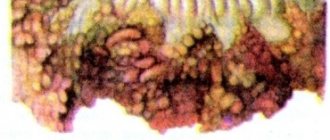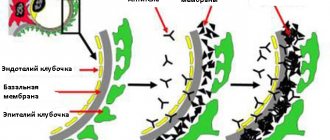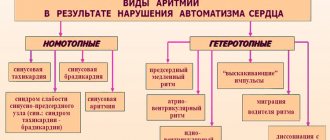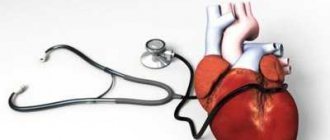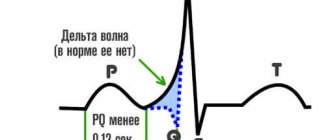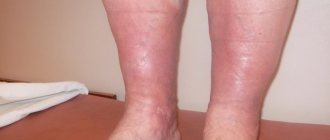Eisenmenger syndrome is a condition that includes a combination of symptoms: cyanosis (pale blue, grayish skin due to decreased oxygen in the blood), pulmonary hypertension (high pressure in the blood vessels of the lungs), erythrocytosis (increased number of red blood cells from - for a decrease in oxygen in the blood).
It affects adolescents and adults with certain congenital heart defects that are treated late (after early childhood or later) or that are never treated. In rare cases, Eisenmenger syndrome occurs in children born with pulmonary hypertension. In these patients, symptoms associated with cyanosis begin much earlier.
Eisenmenger complex is a vascular disease. Pulmonary hypertension, central shunt flow reversal, and cyanosis secondary to any congenital heart disease (CHD) associated with unrepaired intra- or extracardiac communication.
In this syndrome, the original central left-to-right shunt changes direction from right to left due to long-standing pulmonary hypertension and high pulmonary vascular resistance extending to systemic or suprasystemic levels due to structural pulmonary artery obstruction.
Eisenmenger syndrome causes serious complications in pregnancy, although successful births have been reported. Maternal mortality ranges from 30% to 60%. Occurs due to fainting, blood clots and veins moving to distant locations, hypovolemia, coughing up blood or preeclampsia.
Most deaths occur during or within the first weeks after childbirth. Pregnant women with Eisenmenger syndrome should be hospitalized after the 20th week of pregnancy or earlier if clinical worsening occurs.
Is this a syndrome or a complex?
Obstructive vascular pulmonary disease is an acquired syndrome that occurs secondary to the absence or irrational treatment of congenital heart defects. The disease can manifest itself at any age when sclerosis of the pulmonary vessels occurs.
In contrast, the Eisenmenger complex is a congenital cardiac defect. The disease is represented by a complex of three anomalies: an interventricular septal defect, a reverse position of the aorta and its origin from both ventricles, and an enlargement of the right ventricle. The pathology is also accompanied by pulmonary hypertension.
| Differential diagnosis | Eisenmenger syndrome | Eisenmenger complex |
| Nature of occurrence | Secondary (acquired) | Primary (congenital) |
| Age of detection | Child or adult | Always childish |
| Accompanying illnesses | Primary heart defect | May be the only disease |
| Clinical picture | Same for both diseases | |
Eisenmenger syndrome always develops secondary. For its occurrence, the presence of a congenital heart defect with enrichment of the pulmonary circulation is necessary. The Eisenmenger complex develops primarily (in utero).
Characteristic symptoms
The first external manifestations that attract attention are:
- A bluish tint to the skin of the face, lips and mucous membranes.
- Pallor of the skin during exercise.
- Thickening of the phalanges of the fingers of the upper extremities.
- Deformation of the chest (protrusion forward).
- Increased fatigue.
- Chest pain that radiates to the arm, shoulder blade or jaw.
- Arrhythmia.
- Shortness of breath after exercise, a cough with bloody sputum may also occur.
When palpating the chest, a significant bulge is detected, formed by a pathologically enlarged right ventricle.
When listening with a phonendoscope, the following deviations are noted:
- Decreasing high-frequency diastolic murmur along the left edge of the sternum.
- Enhanced pulmonary component of tone II.
- Brief systolic murmur in the absence of continuous murmur of open arterial flow.
- High frequency pulmonary ejection click.
- Pathological IV heart sound.
- Splitting of the second tone with the noise of the reverse direction of blood in case of tricuspid valve insufficiency.
Development mechanism, causes and risk factors
The pathology is a complication of congenital heart defects with left-to-right shunting. The following causative (primary) diseases are distinguished:
- A ventricular septal defect is a hole in the septum between the ventricles, the most common cause of the syndrome.
- An atrial septal defect is a hole in the tissue that separates the atria.
- Patent ductus arteriosus is a disorder in which the ductus arteriosus does not close in the first days of a child’s life and continues to supply arterial blood to the lungs.
- A patent atrioventricular canal is a complex, rare defect that combines a hole at the site of fusion of the interventricular and interatrial septum with pathology of the mitral valve.
- The aortopulmonary window is a pathological shunt between the pulmonary artery and the aorta.
- Transposition of the great vessels.
In these diseases, pulmonary blood flow is enriched. In response to this, a spasm occurs in the blood vessels of the lungs, aimed at limiting the flow of blood. At this stage, pulmonary hypertension is reversible.
The disease can also develop in patients after surgical creation of a systemic-pulmonary shunt or anastomosis during palliative correction of congenital defects.
Eisenmenger syndrome develops when a heart defect goes undetected before symptoms of pulmonary artery damage appear, or the patient does not receive adequate treatment, including surgery, to compensate for it. Most untreated children develop pulmonary hypertension in the second year of life .
Long-term lack of treatment for defects leads to constant vascular spasm. Vascular rigidity develops - irreversible sclerosis of the vascular walls, which lose the ability to contract and relax. Pulmonary hypertension becomes irreversible .
Increased vascular resistance in the lungs means that blood cannot flow into the lungs from the pulmonary artery. As a result, the pathological left-to-right blood discharge changes to right-to-left.
The presence of congenital defects in the family history also increases the risk of having a child with a similar defect and the occurrence of the syndrome.
Definition
Eisenmenger syndrome is a disorder of the intrauterine development of the heart muscle, which includes the presence of a defect in the septum between the ventricles, a mirrored position of the aorta, and an increase in the size of the right ventricle. Fortunately, this defect can be successfully operated on, and children subsequently grow and develop in the same way as their peers.
Development and stages of the disease
In a healthy heart, the chambers and vessels are securely separated by partitions and valves that regulate the direction of blood flow. The right ventricle and atrium send venous blood to the lungs, where it is saturated with oxygen. The left chambers take enriched blood and pump it into the aorta and further through the systemic circulation.
With defects with enrichment of the pulmonary circle, the lungs receive an excess volume of blood. Under the influence of constant increased load, the small vessels of the lungs are damaged, and the pressure in them increases. This condition is called arterial pulmonary hypertension.
Due to increased vascular resistance, venous blood can no longer enter the lungs in full, mixes with arterial blood and is directed through the left ventricle or atrium into the aorta - a condition arises when the
direction of blood flow through the window in the septum changes .
The oxygen concentration in the blood drops, which causes increased production of red blood cells, cyanosis, and shortness of breath.
In 1958, American cardiologists Heath and Edwards proposed a description of the development of the syndrome through the stages of histological changes in the vessels of the lungs. At the initial stages, the changes are reversible and are characterized by stretching of the pulmonary arteries and proliferation of their inner layer.
As the disease progresses, small arteries become sclerotized due to the replacement of elastic connective tissue (fibrosis), and signs of atherosclerosis of large arteries appear. The expansion progresses, and plexiform damage to small arteries increases. At the last stage, necrotic lesions of the arteries are observed as a result of thrombosis, fibrosis, infiltration of the arterial wall with leukocytes and eosinophils.
Methods for diagnosing the condition
Upon examination, signs of cyanosis of the skin, lips, deformation of the fingers and chest, and heart pulsation to the left of the sternum are noticeable. Auscultation reveals a rough noise during systole, which is accompanied by a “cat’s purring” upon palpation. Diastolic murmur may reflect relative pulmonary artery insufficiency. The second tone above the pulmonary artery is accentuated. A continuous murmur occurs when the aortic duct is open.
Data from additional diagnostic methods:
- Ultrasound of the heart reveals all the characteristic changes - disposition of the aorta, defect of the septum between the chambers, enlargement of the right ventricle.
- X-ray – the trunk of the pulmonary artery is bulging, the roots of the lungs are pulsating, the heart is in the form of a ball or shoe.
- ECG - signs of a hypertrophied right ventricle.
- Catheterization of the cavities is necessary to measure the pressure in them.
- Blood gas composition shows low oxygen content.
- An end-stage blood test reveals polycythemia (high red blood cell count).
Danger and complications
Without appropriate treatment and monitoring, complications may develop with Eisenmenger syndrome, including:
- Cyanosis is a decrease in oxygen content in the blood. Initially it occurs because a large circle of blood supply is deprived of the volume of blood going to the lungs. Cyanosis causes a characteristic bluish discoloration of the skin and leads to increased fatigue during physical activity. Over time, this complication progresses.
- Erythrocytosis is increased production of red blood cells in response to hypoxia. An excess number of red blood cells increases the risk of blood clots and complicates the blood supply to organs and tissues.
- Arrhythmia is a disturbance in heart rhythm due to thickening of the heart walls and lack of oxygen. With some types of arrhythmia, the chambers of the heart become overfilled with blood, which contributes to the formation of blood clots. Blockage of a large artery by a blood clot can lead to a heart attack or cause an attack of angina.
- Sudden cardiac arrest is a cessation of cardiac function caused by an arrhythmia, accompanied by loss of consciousness and respiratory arrest. Without immediate medical attention, death can occur within minutes.
- Heart failure is a decrease in the pumping capacity of the heart muscles due to constant high blood pressure.
- Hemoptysis – increased blood pressure in the lungs can lead to life-threatening bleeding in the lungs.
- Stroke - Blood clots traveling through the bloodstream can accidentally block a vessel in the brain.
- Impaired kidney function - when oxygen levels in the blood are low, the kidneys cannot function properly. As a result of an increase in uric acid levels in the blood (hyperuricemia), secondary gout may develop.
- An increase in the level of bilirubin in the blood is the result of the breakdown of a large number of red blood cells. May cause the growth of gallstones.
Symptoms
Symptoms of Eisenmenger syndrome and PAH are nonspecific and develop slowly . This makes it difficult to make a diagnosis in patients with previously undetected heart disease.
The most common symptoms:
- cyanosis, bluish or gray coloration of the skin and lips,
- shortness of breath during exercise and at rest,
- pain or pressure in the chest,
- arrhythmia or tachycardia,
- syncope - fainting caused by a brief disruption of blood flow in the vessels of the brain,
- headache,
- dizziness,
- swelling, numbness of fingers and toes,
- “drumsticks and watch glasses” - characteristic changes in the fingers and nails due to the proliferation of connective tissue.
Do you know what unusual symptoms may indicate the presence of heart disease? Explore the top most unexpected signs!
Symptoms of cardiac pathology
At first, the disease does not manifest itself in any way, so children with the “white” stage of the syndrome grow and develop normally, keeping up with their peers. But, as soon as the direction of the discharge changes, the following clinical picture is formed:
- persistent bluishness of the skin,
- labored breathing,
- low exercise tolerance,
- weakness,
- headache,
- frequent heartbeat,
- fainting states,
- bleeding from the nose and alveoli (hemoptysis).
To facilitate breathing, patients squat down. Due to the pressure of the wide and dense pulmonary artery on the recurrent nerve, hoarseness occurs. A typical manifestation is frequent respiratory diseases - pneumonia and bronchitis, characterized by a protracted course and resistance to traditional therapy.
The spine and chest are deformed, a cardiac hump appears, and the fingers, due to chronic oxygen starvation, take on the shape of drumsticks.
Eisenmenger's disease can cause the following complications:
- bleeding from the lungs,
- pulmonary tissue infarction,
- thrombosis or embolism of the pulmonary arteries,
- endocarditis.
The average duration without surgery does not exceed 25 years, death is often associated with circulatory failure.
Watch the video about heart defects in children:
When to see a doctor?
The symptoms described above do not necessarily indicate Eisenmenger syndrome and pulmonary hypertension, but the occurrence of any of them is a reason to contact a physician and cardiologist, as well as the appearance of other signs of heart defects.
Cyanosis, shortness of breath, and edema indicate a serious malfunction of the organs and systems of the body, even if the patient has not previously been diagnosed with a heart defect.
If you suspect Eisenmenger syndrome, your doctor may need to:
- Information about any heart surgery, if the defect has already been diagnosed and corrected.
- Family history, that is, information about relatives with congenital heart defects, diabetes, hypertension, as well as those who have suffered a stroke or myocardial infarction.
- A list of all medications, including vitamins and dietary supplements, that the patient takes.
Eisenmenger syndrome
The obvious progress of medicine over the past few decades has by no means led to a sharp increase in life expectancy or the eradication of heart pathologies. Moreover, at the turn of the 19th and 20th centuries, doctors “discovered” many diseases, the causes of which are still not clear, the symptoms are vague and not obvious, and treatment is very difficult.
Eisenmenger syndrome, named after the Austrian pediatrician and cardiologist Victor Eisenmenger, is not considered widespread. This rather rare pathology was described more than 100 years ago, but even today there is no clear understanding of its etiology and pathophysiology.
A harmless medical curiosity not found in everyday life, you say? Unfortunately no.
The essence of the problem
Eisenmenger syndrome (ES), sometimes called the Eisenmenger complex, is a complex and very dangerous pathology that affects both the heart and lungs.
It is characterized by significantly increased pulmonary vascular resistance (hypertension), progressive right ventricular failure, and a congenital ventricular septal defect.
This leads to a strong increase in pressure in the right atrium and abnormal functioning of the pulmonary circulation.
Some doctors understand SE as any congenital heart defects characterized by a patent ductus arteriosus and atrioventricular canal, as well as the presence of only one ventricle, but this does not change the essence of the matter.
Causes
There is still no generally accepted theory explaining the mechanism of formation of SE (as well as any other congenital heart defects). But the etiological factors that increase the risk of having children with serious pathologies of the cardiovascular system are well known:
1. Hereditary predisposition
The existence of the SE gene, transmitted from parent to child, has not yet been proven, although the project to decipher the human genome, begun in 1990, has already been completed (2003). Therefore, in general, it is impossible to say that the baby will definitely inherit a predisposition to certain heart pathologies from his mother or father.
2. Environmental factors
- toxic damage during intrauterine development (possible causes: polluted atmosphere, harmful production conditions, poisoning with heavy metal vapors);
- a side effect of a woman taking certain potent medications during pregnancy;
- dietary supplements of dubious quality, used by the expectant mother, who do not have the necessary certificates and permits;
- prolonged exposure to increased radiation or electromagnetic radiation;
- chronic infectious disease of one of the parents.
As is easy to see, all these factors are not characteristic of SE and theoretically can cause the development of many different diseases.
Diagnostics
If PAH and Eisenmenger syndrome are suspected, the cardiologist should conduct a number of studies, which may include:
- An electrocardiogram is a recording of the electrical activity of the heart. Can show the disorders that caused the patient's condition.
- Chest X-ray - in PAH, the image shows enlargement of the heart and pulmonary arteries.
- Ultrasound examination - allows you to examine in detail changes in the structures of the heart and evaluate blood flow through the chambers and valves.
- General and biochemical blood test - prescribed to assess characteristic changes in the composition of the blood.
- Computed tomography - allows you to obtain a detailed image of the lungs, can be performed with or without contrast.
- Cardiac catheterization is the insertion of a catheter into the heart (usually through the femoral artery). In this study, you can measure the pressure directly in the ventricles and atria, assessing the volume of blood circulating in the heart and lungs. It is performed under anesthesia.
- Stress test - takes an ECG while the patient rides an exercise bike or walks on a treadmill.
Differential diagnosis is made with PAH of another etiology.
Course and treatment in adults and children
The disease occurs in untreated patients with congenital cardiac anomalies. The appearance of the clinic depends on the severity of the defect: the more pronounced it is, the sooner spasm and rigidity of the pulmonary vessels will develop.
More frequent detection in children is due to the following reasons:
- Most children with severe birth defects do not survive to adulthood.
- Manifestations of congenital anomalies in children are more pronounced.
- Specific symptoms of congenital malformations contribute to early detection of the disease.
Differences in the clinic and course in children:
- Manifestations of the underlying disease predominate.
- Frequent episodes of cardiac pulmonary edema.
- Pulmonary hypertension increases rapidly to 50 mm or more. rt. Art.
- Cyanosis is widespread on all skin integuments.
In adulthood, nonspecific signs predominate:
- Shortness of breath on exertion.
- Cyanosis of lips, ears, fingertips.
- Weakness.
- Arrhythmia.
- Chronic heart failure.
- Headache.
In both groups of patients, an increase in the level of red blood cells and blood thickening due to chronic hypoxia are detected, but adults are more prone to thrombosis than children.
Sudden cardiac death syndrome is also more common in adults. Currently, there are no methods for completely curing Eisenmenger syndrome. Patients with PAH should be observed by a cardiologist and regularly monitor blood pressure and blood counts. All measures taken are aimed at maintaining quality of life, relieving symptoms of the disease, and preventing complications .
Treatment in children is surgical. For this disease, operations often take place in several stages and include:
- Restoration of normal cardiac anatomy.
- Removing the shunt.
- Decreased pressure in the pulmonary trunk.
In patients with an advanced stage of the disease (adults), palliative therapy is carried out aimed at improving the quality of life. The following groups of drugs are used in treatment:
- Cardiac glycosides.
- Diuretics.
- Beta blockers and calcium channel blockers.
- Cardioprotectors.
The main components of combination drug therapy for PAH:
- Sildenafil and other phosphodiesterase type 5 inhibitors are used for their relaxing effect on the smooth muscle walls of blood vessels.
- Taking endothelin receptor antagonists helps maintain a satisfactory condition of the pulmonary vessels. The question of long-term therapy with these drugs remains open, since some research results show their negative effect on the heart.
- The use of prostacyclins can reduce pressure in the pulmonary artery, improve oxygen consumption by muscles and partially reverse pulmonary vascular damage.
- Antiarrhythmic drugs are used to regularize the heart rhythm and reduce the risks associated with arrhythmia.
- Taking aspirin or other anticoagulants is recommended to reduce blood viscosity.
Options for a lung-heart complex transplant operation are being developed . The disadvantage of this method is numerous complications and an unpredictable waiting period for a donor.
Treatment
Despite the eternal confrontation between surgeons and therapists, in the case of this disease they agreed that it is necessary to treat it jointly, since conservative treatment by itself does not give the desired effect, and surgical treatment cannot provide stable remission. Therefore, a set of measures was developed to eliminate Eisenmenger syndrome:
- Bloodletting (in modern terms this is called “phlebotomy”). A simple and trouble-free solution. It is used in patients with proven pathology a couple of times a year. Before and after the procedure, blood viscosity and hemoglobin levels must be determined.
- Use of oxygen inhalation. Used as an adjuvant therapy to combat cyanosis and secondary hypoxia. In addition, they have a psychosomatic effect on patients.
- Anticoagulants. They do not have a sufficient level of evidence, since you can fall from the fire into the fire and, instead of thinning the blood, get it completely non-coagulable.
- Other medications: - diuretics to relieve pulmonary edema; - drugs to improve hemodynamics.
- Surgical technique: — pacemaker to compensate for arrhythmia; — complete elimination of the ventricular septal defect and closure of the anomalous shunt.
How exactly to treat Eisenmenger syndrome must be decided with your doctor or even several specialists. Since no method can guarantee success.
About prevalence and life expectancy
Patient population: untreated patients with congenital cardiac anomalies.
Detection: in children - in 10-12% of cases, in adults - in 7-8% of cases.
Etiology: septal interventricular defect (60.5%), septal interventricular defect (32% of cases).
Prognosis: relatively favorable if the disease is detected early (in the first year of life). Detection of the syndrome in adults often indicates the possibility of only palliative therapy. With a long course of the disease, irreversible changes in the lungs and heart lead to atrial fibrillation, thrombosis and heart failure. Under such conditions, even complete surgical treatment of the congenital defect does not lead to recovery.
The average life expectancy is 18-40 years.
Is pregnancy possible?
Pregnancy is extremely undesirable with Eisenmenger syndrome and carries a high risk of death of the mother and fetus. If pregnancy continues, constant monitoring of the condition of the heart and blood vessels is required, since the load on them increases as the fetus develops.
Caesarean section has a high mortality rate for women with PAH, so vaginal delivery with epidural analgesia is recommended.
What improves the prognosis?
The prognosis for life is most favorable in children when Eisenmenger syndrome is detected in the early stages. Surgical correction can stop vascular sclerosis and reduce pressure in the lungs. Other factors for improving prognosis:
- Low severity of heart defects.
- Adequate drug preparation for surgery.
- Rational surgical intervention.
- Lifelong monitoring of the level of red blood cells and platelets in the blood.
Precautions for Eisenmenger complex include:
- The use of antibiotics to prevent infective endocarditis before and after surgical interventions, including dental ones.
- Vaccination against pneumococcus, influenza and other infections that can cause high fever and increase the load on the heart.
- Quitting smoking and being in smoking company.
- Be careful when taking any medications, including dietary supplements.
Eisenmenger syndrome is a life-threatening condition. The prognosis for this disease depends on the defect that caused it and the ability to receive adequate treatment.
